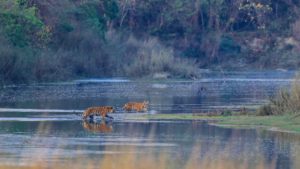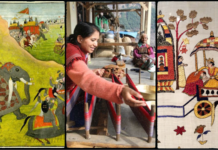
Samantha Hella is a biologist and filmmaker with experience in research in Human-Tiger conflict around Chitwan National Park. She first went to Nepal to research Tiger Biology in the year 2014. Samantha and her fellow classmate Emily Erhart started up with a non-profit organization after returning from Nepal post their graduation. Project Conservation is very forthcoming about building the bridge between the language gap that exists between the public and science by addressing ecological topics through media publications. All the donations made directly goes to the Project Conservation. Their first project ‘Rebuilding Nepal’ raised 10k$ to rebuild the village Majhuwa, the home of Nepali wildlife technicians after the devastating 2015 earthquake.
Project Conversation‘s mission is defined to forecast a broader and deeper understanding of tigers and illuminate the conservation strategies through a film. The film fosters community tolerance, and in return take steps towards coexistence that will benefit both humans and tigers.

Their newest Project and also the first feature film is ” The Last Tiger” talks about the challenges of conserving Tiger in a full-grown human-dominated landscape and Samantha quotes Nepal to be one of the richest Tiger conserving centers as there is a heavy reduction in poaching and luckily the Tiger habitats are increasing (~200 in no.). The film takes its viewers through the grasslands of Chitwan National Park and the buffer zone community surrounding the park to explore the fifth largest tiger population in the world. This film also supports the journey of these biologists and the final efforts they have put in to save the animal from extinction, they have dedicated their lives on. They attempt to convey their research and convince the world why tigers are vital for our own survival. While the human population continues to rise worldwide, and as tigers live in some of the most populated countries in the world, biologists ask themselves, how can we co-exist and live together with wildlife.
There are eminent Nepali biologists Bishnu and Harakaman Lama and Dr.Dave Smith from the U.S. Dr.Dave Smith is a professor in Department of Fisheries, Wildlife and Conservation Biology at the University of Minnesota. The Nepali biologists and Dr.Smith have been continuously working on saving the tiger and conserving them for more than 4 decades in Nepal in spite of the fact that they have been attacked by wild animals.While the other biologists venture into the dense forests and capture the Tiger Cubs, Dave Smith has spent almost 40 years in tracking Tigers with just one goal in his mind: ‘To achieve larger and more secure population of Tigers by keeping their preys abundant and their habitat connected rather than it being patchy or scattered’ because the top predators in ecosystem health matter a lot.
It is observed that as the growth of community forests brings more tigers, attacks on people increase. In one area of Nepal, deaths from tiger attacks have risen sevenfold, with women being the majority of victims. Samantha Helle, a former student of Smith’s, works with women’s groups in Nepal to reduce future human-tiger conflict and thus keeping the prey for the Tigers in abundance come into play.
Samantha and Emily are a team working towards a common goal by dedicating themselves to a broad dissemination of conservation research. The next chapter in Tiger conservation is in the process, providing relief to the communities with the Tigers in the backyards. They are working with the Nepali wildlife Photographer Sagar Giri, The National Trust for Nature Conservation and Dr.Dave Smith to bring about change and save the Tigers.





















